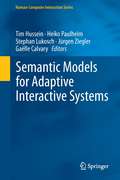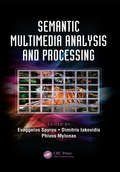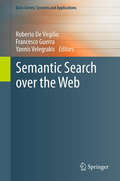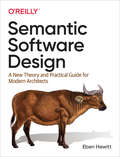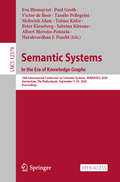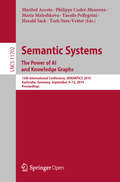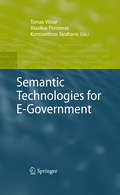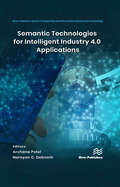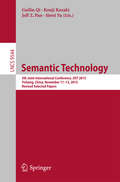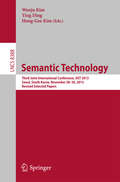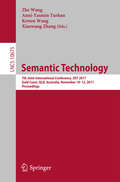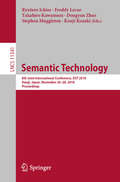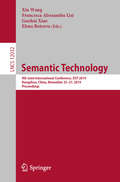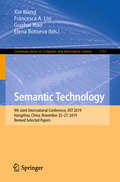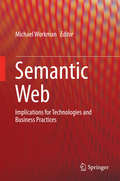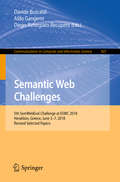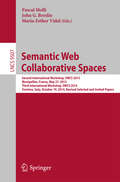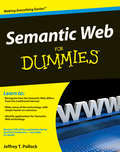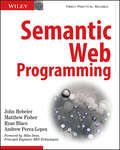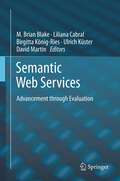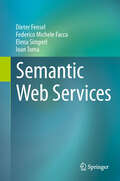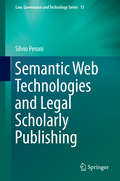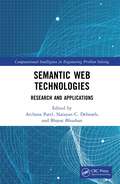- Table View
- List View
Semantic Models for Adaptive Interactive Systems
by Gaëlle Calvary Stephan Lukosch Tim Hussein Jürgen Ziegler Heiko PaulheimProviding insights into methodologies for designing adaptive systems based on semantic data, and introducing semantic models that can be used for building interactive systems, this book showcases many of the applications made possible by the use of semantic models. Ontologies may enhance the functional coverage of an interactive system as well as its visualization and interaction capabilities in various ways. Semantic models can also contribute to bridging gaps; for example, between user models, context-aware interfaces, and model-driven UI generation. There is considerable potential for using semantic models as a basis for adaptive interactive systems. A variety of reasoning and machine learning techniques exist that can be employed to achieve adaptive system behavior. The advent and rapid growth of Linked Open Data as a large-scale collection of semantic data has also paved the way for a new breed of intelligent, knowledge-intensive applications. Semantic Models for Adaptive Interactive Systems includes ten complementary chapters written by experts from both industry and academia. Rounded off by a number of case studies in real world application domains, this book will serve as a valuable reference for researchers and practitioners exploring the use of semantic models within HCI.
Semantic Multimedia Analysis and Processing (Digital Imaging and Computer Vision #9)
by Evaggelos SpyrouBroad in scope, Semantic Multimedia Analysis and Processing provides a complete reference of techniques, algorithms, and solutions for the design and the implementation of contemporary multimedia systems. Offering a balanced, global look at the latest advances in semantic indexing, retrieval, analysis, and processing of multimedia, the book features the contributions of renowned researchers from around the world. Its contents are based on four fundamental thematic pillars: 1) information and content retrieval, 2) semantic knowledge exploitation paradigms, 3) multimedia personalization, and 4) human-computer affective multimedia interaction. Its 15 chapters cover key topics such as content creation, annotation and modeling for the semantic web, multimedia content understanding, and efficiency and scalability. Fostering a deeper understanding of a popular area of research, the text: Describes state-of-the-art schemes and applications Supplies authoritative guidance on research and deployment issues Presents novel methods and applications in an informative and reproducible way Contains numerous examples, illustrations, and tables summarizing results from quantitative studies Considers ongoing trends and designates future challenges and research perspectives Includes bibliographic links for further exploration Uses both SI and US units Ideal for engineers and scientists specializing in the design of multimedia systems, software applications, and image/video analysis and processing technologies, Semantic Multimedia Analysis and Processing aids researchers, practitioners, and developers in finding innovative solutions to existing problems, opening up new avenues of research in uncharted waters.
Semantic Search over the Web
by Roberto De Virgilio Francesco Guerra Yannis VelegrakisThe Web has become the world's largest database, with search being the main tool that allows organizations and individuals to exploit its huge amount of information. Search on the Web has been traditionally based on textual and structural similarities, ignoring to a large degree the semantic dimension, i.e., understanding the meaning of the query and of the document content. Combining search and semantics gives birth to the idea of semantic search. Traditional search engines have already advertised some semantic dimensions. Some of them, for instance, can enhance their generated result sets with documents that are semantically related to the query terms even though they may not include these terms. Nevertheless, the exploitation of the semantic search has not yet reached its full potential. In this book, Roberto De Virgilio, Francesco Guerra and Yannis Velegrakis present an extensive overview of the work done in Semantic Search and other related areas. They explore different technologies and solutions in depth, making their collection a valuable and stimulating reading for both academic and industrial researchers. The book is divided into three parts. The first introduces the readers to the basic notions of the Web of Data. It describes the different kinds of data that exist, their topology, and their storing and indexing techniques. The second part is dedicated to Web Search. It presents different types of search, like the exploratory or the path-oriented, alongside methods for their efficient and effective implementation. Other related topics included in this part are the use of uncertainty in query answering, the exploitation of ontologies, and the use of semantics in mashup design and operation. The focus of the third part is on linked data, and more specifically, on applying ideas originating in recommender systems on linked data management, and on techniques for the efficiently querying answering on linked data.
Semantic Search over the Web (Data-Centric Systems and Applications)
by Roberto De Virgilio Francesco Guerra Yannis VelegrakisThe Web has become the world’s largest database, with search being the main tool that allows organizations and individuals to exploit its huge amount of information. Search on the Web has been traditionally based on textual and structural similarities, ignoring to a large degree the semantic dimension, i.e., understanding the meaning of the query and of the document content. Combining search and semantics gives birth to the idea of semantic search. Traditional search engines have already advertised some semantic dimensions. Some of them, for instance, can enhance their generated result sets with documents that are semantically related to the query terms even though they may not include these terms. Nevertheless, the exploitation of the semantic search has not yet reached its full potential. In this book, Roberto De Virgilio, Francesco Guerra and Yannis Velegrakis present an extensive overview of the work done in Semantic Search and other related areas. They explore different technologies and solutions in depth, making their collection a valuable and stimulating reading for both academic and industrial researchers.The book is divided into three parts. The first introduces the readers to the basic notions of the Web of Data. It describes the different kinds of data that exist, their topology, and their storing and indexing techniques. The second part is dedicated to Web Search. It presents different types of search, like the exploratory or the path-oriented, alongside methods for their efficient and effective implementation. Other related topics included in this part are the use of uncertainty in query answering, the exploitation of ontologies, and the use of semantics in mashup design and operation. The focus of the third part is on linked data, and more specifically, on applying ideas originating in recommender systems on linked data management, and on techniques for the efficiently querying answering on linked data.
Semantic Software Design: A New Theory and Practical Guide for Modern Architects
by Eben HewittWith this practical book, architects, CTOs, and CIOs will learn a set of patterns for the practice of architecture, including analysis, documentation, and communication. Author Eben Hewitt shows you how to create holistic and thoughtful technology plans, communicate them clearly, lead people toward the vision, and become a great architect or Chief Architect.This book covers each key aspect of architecture comprehensively, including how to incorporate business architecture, information architecture, data architecture, application (software) architecture together to have the best chance for the system’s success.Get a practical set of proven architecture practices focused on shipping great products using architectureLearn how architecture works effectively with development teams, management, and product management teams through the value chainFind updated special coverage on machine learning architectureGet usable templates to start incorporating into your teams immediatelyIncorporate business architecture, information architecture, data architecture, and application (software) architecture together
Semantic Systems. In the Era of Knowledge Graphs: 16th International Conference on Semantic Systems, SEMANTiCS 2020, Amsterdam, The Netherlands, September 7–10, 2020, Proceedings (Lecture Notes in Computer Science #12378)
by Paul Groth Tassilo Pellegrini Peter Kieseberg Eva Blomqvist Mehwish Alam Sabrina Kirrane Victor De Boer Tobias Käfer Albert Meroño-Peñuela Harshvardhan J. PanditThis open access book constitutes the refereed proceedings of the 16th International Conference on Semantic Systems, SEMANTiCS 2020, held in Amsterdam, The Netherlands, in September 2020. The conference was held virtually due to the COVID-19 pandemic.
Semantic Systems. The Power of AI and Knowledge Graphs: 15th International Conference, SEMANTiCS 2019, Karlsruhe, Germany, September 9–12, 2019, Proceedings (Lecture Notes in Computer Science #11702)
by Harald Sack Tassilo Pellegrini Philippe Cudré-Mauroux Maria Maleshkova Maribel Acosta York Sure-VetterThis open access book constitutes the refereed proceedings of the 15th International Conference on Semantic Systems, SEMANTiCS 2019, held in Karlsruhe, Germany, in September 2019. The 20 full papers and 8 short papers presented in this volume were carefully reviewed and selected from 88 submissions. They cover topics such as: web semantics and linked (open) data; machine learning and deep learning techniques; semantic information management and knowledge integration; terminology, thesaurus and ontology management; data mining and knowledge discovery; semantics in blockchain and distributed ledger technologies.
Semantic Technologies for E-Government
by Tomas Vitvar Konstantinos Tarabanis Vassilios PeristerasE-government faces huge challenges in achieving interoperability and integration, taking into account differences in laws, regulations, services, administrative processes and languages across regions and countries. On the other hand, issues like service, data and process integration have been researched by the Semantic Web community for several years now, and in the last two to three years we have witnessed the first applications of semantic technologies in real, operational e-government systems in both Europe and the US which address exactly these challenges. With this book, the editors present the latest research results on how to use semantic technologies in order to improve or even revolutionize the use of ICT in public administration systems. The contributions are organized into three parts: architectures and process integration, ontologies and interoperability, and portals and user interactions. They give a broad overview of how semantic technologies have been applied in different e-government projects funded from the European program for ICT Research and Development, and they cover a wide spectrum of semantic technologies such as development of domain and service ontologies, semantic enhancements of business process models, semantic Service-Oriented Architectures (SOAs) based on Semantic Web Services (SWS) frameworks, and ontology-based knowledge management. In this volume, researchers of Semantic Web technologies will find a wealth of challenging real-world scenarios to stimulate new fields of research, while developers of e-government systems as well as other stakeholders in public administration will appreciate the detailed presentations and discussions of numerous applications in areas such as e-government portals, personalization of Web-based public services, or integration and orchestration of public administration processes.
Semantic Technologies for Intelligent Industry 4.0 Applications (River Publishers Series in Computing and Information Science and Technology)
by Narayan C. Debnath Archana PatelAs the world enters the era of big data, there is a serious need to give a semantic perspective to the data in order to find unseen patterns, derive meaningful information, and make intelligent decisions. Semantic technologies offer the richest machine-interpretable (rather than just machine-processable) and explicit semantics that are being extensively used in various domains and industries. These technologies reduce the problem of large semantic loss in the process of modelling knowledge, and provide sharable, reusable knowledge,and a common understanding of the knowledge. As a result, the interoperability and interconnectivity of the model make it priceless for addressing the issues of querying data. These technologies work with the concepts and relations that are very lose to the working of the human brain. They provide a semantic representation of any data format: unstructured or semi-structured. As a consequence, data becomes real-world entity rather than a string of characters. For these reasons, semantic technologies are highly valuable tools to simplify the existing problems of the industry leading to new opportunities. However, there are some challenges that need to be addressed to make industrial applications and machines smarter. This book aims to provide a roadmap for semantic technologies and highlights the role of these technologies in industry. The book also explores the present and future prospects of these semantic technologies along with providing answers to various questions like: Are semantic technologies useful for the next era (industry 4.0)? Why are semantic technologies so popular and extensively used in the industry? Can semantic technologies make intelligent industrial applications? Which type of problem requires the immediate attention of researchers? Why are semantic technologies very helpful in people’s future lives? This book will potentially serve as an important guide towards the latest industrial applications of semantic technologies for the upcoming generation, and thus becomes a unique resource for scholars, researchers, professionals and practitioners in the field.
Semantic Technology
by Guilin Qi Kouji Kozaki Jeff Z. Pan Siwei YuThisbook constitutes the thoroughly refereed proceedings of the 5th JointInternational Semantic Technology Conference, JIST 2015, held in Yichang,China, in November 2015. The theme of the JIST 2015 conference was "Big Data andSocial Media". The JIST 2015 conference consisted of main technical tracksincluding 2 keynotes, 2 invited talks, a regular technical paper track (fulland short papers), an in-use track, a poster and demo session, workshop, andtutorial. The 14 full and 8 short papers in this volume were carefullyreviewed and selected from 43 submissions. The paper cover the followingtopics: ontology and reasoning, linked data, learning and discovery, RDF andquery, knowledge graph, knowledge integration, query and recommendation, andapplications of semantic technologies.
Semantic Technology
by Ying Ding Wooju Kim Hong-Gee KimThis book constitutes the proceedings of the Third Joint International Semantic Technology Conference, JIST 2013, held in Seoul, South Korea, in November 2013. The 32 papers, included four tutorials and 5 workshop papers, in this volume were carefully reviewed and selected from numerous submissions. The contributions are organized in topical sections on semantic Web services, multilingual issues, biomedical applications, ontology construction, semantic reasoning, semantic search and query, ontology mapping, and learning and discovery.
Semantic Technology: 7th Joint International Conference, JIST 2017, Gold Coast, QLD, Australia, November 10-12, 2017, Proceedings (Lecture Notes in Computer Science #10675)
by Zhe Wang Anni-Yasmin Turhan Kewen Wang Xiaowang ZhangThis book constitutes the thoroughly refereed proceedings of the 7th Joint International Semantic Technology Conference, JIST 2017, held in Goldcoast, QLD, Australia, in November 2017. The 19 full papers and 4 short papers presented were carefully reviewed and selected from 37 submissions. They present applications of semantic technologies, theoretical results, new algorithms and tools to facilitate the adoption of semantic technologies and are organized in topical sections on ontology and data management; ontology reasoning; linked data and query; information retrieval and knowledge discovery; knowledge graphs; and applications of semantic technologies.
Semantic Technology: 8th Joint International Conference, JIST 2018, Awaji, Japan, November 26–28, 2018, Proceedings (Lecture Notes in Computer Science #11341)
by Kouji Kozaki Dongyan Zhao Freddy Lecue Ryutaro Ichise Takahiro Kawamura Stephen MuggletonThis book constitutes the thoroughly refereed proceedings of the 8th Joint International Semantic Technology Conference, JIST 2018, held in Awaji, Japan, in November 2018. The 23 full papers and 6 short papers presented were carefully reviewed and selected from 75 submissions. They present applications of semantic technologies, theoretical results, new algorithms and tools to facilitate the adoption of semantic technologies and are organized in topical sections on knowledge graphs; data management; question answering and NLP; ontology and reasoning; government open data; and semantic web for life sciences.
Semantic Technology: 9th Joint International Conference, JIST 2019, Hangzhou, China, November 25–27, 2019, Proceedings (Lecture Notes in Computer Science #12032)
by Xin Wang Francesca Alessandra Lisi Guohui Xiao Elena BotoevaThis book constitutes the thoroughly refereed proceedings of the 9th Joint International Semantic Technology Conference, JIST 2019, held in Hangzhou, China, in November 2019. The 24 full papers presented were carefully reviewed and selected from 70 submissions. They present applications of semantic technologies, theoretical results, new algorithms and tools to facilitate the adoption of semantic technologies and are organized in topical sections on knowledge graphs; data management; question answering and NLP; ontology and reasoning; government open data; and semantic web for life sciences.
Semantic Technology: 9th Joint International Conference, JIST 2019, Hangzhou, China, November 25–27, 2019, Revised Selected Papers (Communications in Computer and Information Science #1157)
by Xin Wang Francesca A. Lisi Guohui Xiao Elena BotoevaThis book constitutes the thoroughly refereed proceedings of the 9th Joint International Semantic Technology Conference, JIST 2019, held in Hangzhou, China, in November 2019.The 12 full papers and 12 short papers presented were carefully reviewed and selected from 70 submissions. The papers present applications of semantic technologies, theoretical results, new algorithms and tools to facilitate the adoption of semantic technologies.
Semantic Technology: Third Joint International Conference, JIST 2013, Seoul, South Korea, November 28--30, 2013, Revised Selected Papers (Lecture Notes in Computer Science #8388)
by Wooju Kim, Ying Ding and Hong-Gee KimThis book constitutes the proceedings of the Third Joint International Semantic Technology Conference, JIST 2013, held in Seoul, South Korea, in November 2013.The 32 papers, included four tutorials and 5 workshop papers, in this volume were carefully reviewed and selected from numerous submissions. The contributions are organized in topical sections on semantic Web services, multilingual issues, biomedical applications, ontology construction, semantic reasoning, semantic search and query, ontology mapping, and learning and discovery.
Semantic Web
by Michael WorkmanThis book examines recent developments in semantic systems that can respond to situations and environments and events. The contributors to this book cover how to design, implement and utilize disruptive technologies. The editor discusses the two fundamental sets of disruptive technologies: the development of semantic technologies including description logics, ontologies and agent frameworks; and the development of semantic information rendering and graphical forms of displays of high-density time-sensitive data to improve situational awareness. Beyond practical illustrations of emerging technologies, the editor proposes to utilize an incremental development method called knowledge scaffolding -a proven educational psychology technique for learning a subject matter thoroughly. The goal of this book is to help readers learn about managing information resources, from the ground up and reinforcing the learning as they read on.
Semantic Web Challenges: 5th SemWebEval Challenge at ESWC 2018, Heraklion, Greece, June 3–7, 2018, Revised Selected Papers (Communications in Computer and Information Science #927)
by Diego Reforgiato Recupero Aldo Gangemi Davide BuscaldiThis book constitutes the thoroughly refereed post conference proceedings of the 4th edition of the Semantic Web Evaluation Challenge, SemWebEval 2018, co-located with the 15th European Semantic Web conference, held in Heraklion, Greece, in June 2018.This book includes the descriptions of all methods and tools that competed at SemWebEval 2018, together with a detailed description of the tasks, evaluation procedures and datasets. The 18 revised full papers presented in this volume were carefully reviewed and selected from 24 submissions. The contributions are grouped in the areas: the mighty storage challenge; open knowledge extraction challenge; question answering over linked data challenge; semantic sentiment analysis.
Semantic Web Collaborative Spaces
by Pascal Molli John G. Breslin Maria-Esther VidalThis book constitutes the thoroughly refereedpost-workshop proceedings of the Second International Workshop on Semantic WebCollaborative Spaces, SWCS 2013, held in Montpellier, France, in May 2013, andthe Third International Workshop on Semantic Web Collaborative Spaces, SWCS2014, held in Trentino, Italy, in October 2014. The 6 revised extended papers presented were carefullyreviewed and selected from 10 submissions. The papers are grouped in topicalsections on challenges in collaborative spaces, modeling collaborativecommunities and the role of semantics, semantic MediaWiki communities, andexploiting semantics in collaborative spaces.
Semantic Web For Dummies
by Jeffrey T. PollockSemantic Web technology is already changing how we interact with data on the Web. By connecting random information on the Internet in new ways, Web 3. 0, as it is sometimes called, represents an exciting online evolution. Whether you're a consumer doing research online, a business owner who wants to offer your customers the most useful Web site, or an IT manager eager to understand Semantic Web solutions, Semantic Web For Dummies is the place to start! It will help you: Know how the typical Internet user will recognize the effects of the Semantic Web Explore all the benefits the data Web offers to businesses and decide whether it's right for your business Make sense of the technology and identify applications for it See how the Semantic Web is about data while the "old" Internet was about documents Tour the architectures, strategies, and standards involved in Semantic Web technology Learn a bit about the languages that make it all work: Resource Description Framework (RDF) and Web Ontology Language (OWL) Discover the variety of information-based jobs that could become available in a data-driven economy You'll also find a quick primer on tech specifications, some key priorities for CIOs, and tools to help you sort the hype from the reality. There are case studies of early Semantic Web successes and a list of common myths you may encounter. Whether you're incorporating the Semantic Web in the workplace or using it at home, Semantic Web For Dummies will help you define, develop, implement, and use Web 3. 0.
Semantic Web Programming
by Matthew Fisher John Hebeler Mike Dean Ryan Blace Andrew Perez-LopezThe next major advance in the Web?Web 3.0?will be built on semantic Web technologies, which will allow data to be shared and reused across application, enterprise, and community boundaries. Written by a team of highly experienced Web developers, this book explains examines how this powerful new technology can unify and fully leverage the ever-growing data, information, and services that are available on the Internet. Helpful examples demonstrate how to use the semantic Web to solve practical, real-world problems while you take a look at the set of design principles, collaborative working groups, and technologies that form the semantic Web. The companion Web site features full code, as well as a reference section, a FAQ section, a discussion forum, and a semantic blog.
Semantic Web Services
by David Martin Brian Blake Birgitta König-Ries Liliana Cabral Ulrich KüsterOver the last decade, a great amount of effort and resources have been invested in the development of Semantic Web Service (SWS) frameworks. Numerous description languages, frameworks, tools, and matchmaking and composition algorithms have been proposed. Nevertheless, when faced with a real-world problem, it is still very hard to decide which of these different approaches to use. In this book, the editors present an overall overview and comparison of the main current evaluation initiatives for SWS. The presentation is divided into four parts, each referring to one of the evaluation initiatives. Part I covers the long-established first two tracks of the Semantic Service Selection (S3) Contest - the OWL-S matchmaker evaluation and the SAWSDL matchmaker evaluation. Part II introduces the new S3 Jena Geography Dataset (JGD) cross evaluation contest. Part III presents the Semantic Web Service Challenge. Lastly, Part IV reports on the semantic aspects of the Web Service Challenge. The introduction to each part provides an overview of the evaluation initiative and overall results for its latest evaluation workshops. The following chapters in each part, written by the participants, detail their approaches, solutions and lessons learned. This book is aimed at two different types of readers. Researchers on SWS technology receive an overview of existing approaches in SWS with a particular focus on evaluation approaches; potential users of SWS technologies receive a comprehensive summary of the respective strengths and weaknesses of current systems and thus guidance on factors that play a role in evaluation.
Semantic Web Services
by Dieter Fensel Elena Simperl Federico Michele Facca Ioan TomaA paradigm shift is taking place in computer science: one generation ago, we learned to abstract from hardware to software, now we are abstracting from software to serviceware implemented through service-oriented computing. Yet ensuring interoperability in open, heterogeneous, and dynamically changing environments, such as the Internet, remains a major challenge for actual machine-to-machine integration. Usually significant problems in aligning data, processes, and protocols appear as soon as a specific piece of functionality is used within a different application context. The Semantic Web Services (SWS) approach is about describing services with metadata on the basis of domain ontologies as a means to enable their automatic location, execution, combination, and use. Fensel and his coauthors provide a comprehensive overview of SWS in line with actual industrial practice. They introduce the main sociotechnological components that ground the SWS vision (like Web Science, Service Science, and service-oriented architectures) and several approaches that realize it, e.g. the Web Service Modeling Framework, OWL-S, and RESTful services. The real-world relevance is emphasized through a series of case studies from large-scale R&D projects and a business-oriented proposition from the SWS technology provider Seekda. Each chapter of the book is structured according to a predefined template, covering both theoretical and practical aspects, and including walk-through examples and hands-on exercises. Additional learning material is available on the book website www.swsbook.org. With its additional features, the book is ideally suited as the basis for courses or self-study in this field, and it may also serve as a reference for researchers looking for a state-of-the-art overview of formalisms, methods, tools, and applications related to SWS.
Semantic Web Technologies and Legal Scholarly Publishing
by Silvio PeroniThis work deals with the applications of Semantic Publishing technologies in the legal domain, i. e. , the use of Semantic Web technologies to address issues related to the Legal Scholarly Publishing. Research in the field of Law has a long tradition in the application of semantic technologies, such as Semantic Web and Linked Data, to real-world scenarios. This book investigates and proposes solutions for three main issues that Semantic Publishing needs to address within the context of the Legal Scholarly Publishing: the need of tools for linking document text to a formal representation of its meaning; the lack of complete metadata schemas for describing documents according to the publishing vocabulary and the absence of effective tools and user interfaces for easily acting on semantic publishing models and theories. In particular, this work introduces EARMARK, a markup meta language that allows one to create markup documents without the structural and semantic limits imposed by markup languages such as XML. EARMARK is a platform to link the content layer of a document with its intended formal semantics and it can be used with the Semantic Publishing and Referencing (SPAR) Ontologies, another topic in this book. SPAR Ontologies are a collection of formal models providing an upper semantic layer for describing the publishing domain. Using EARMARK as a foundation for SPAR descriptions opens up to a semantic characterisation of all the aspects of a document and of its parts. Finally, four user-friendly tools are introduced: LODE, KC-Viz, Graffoo and Gaffe. They were expressly developed to facilitate the interaction of publishers and domain experts with Semantic Publishing technologies by shielding such users from the underlying formalisms and semantic models of such technologies.
Semantic Web Technologies: Research and Applications (Computational Intelligence in Engineering Problem Solving)
by Bharat Bhushan Narayan C. Debnath Archana PatelSemantic web technologies (SWTs) offer the richest machine-interpretable (rather than just machine-processable) and explicit semantics that are being extensively used in various domains and industries. This book provides a roadmap for semantic web technologies (SWTs) and highlights their role in a wide range of domains including cloud computing, Internet of Things, big data, sensor network, and so forth. It also explores the prospects of these technologies including different data interchange formats, query languages, ontologies, Linked Data, and notations. The role of SWTs in ‘epidemic Covid-19’, ‘e-learning platforms and systems’, ‘block chain’, ‘open online courses’, and ‘visual analytics in healthcare’ is described as well. This book: Explores all the critical aspects of semantic web technologies (SWTs) Discusses the impact of SWTs on cloud computing, Internet of Things, big data, and sensor network Offers a comprehensive examination of the emerging research in the areas of SWTs and their related domains Provides a template to develop a wide range of smart and intelligent applications Includes latest applications and examples with real data This book is aimed at researchers and graduate students in computer science, informatics, web technology, cloud computing, and Internet of Things.
